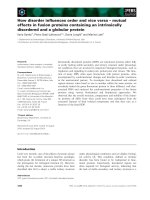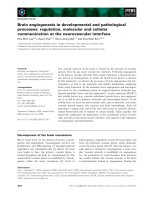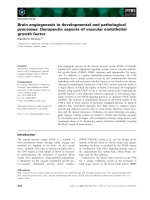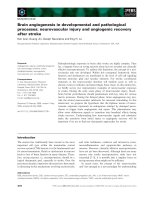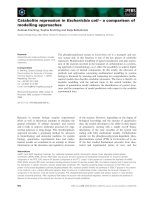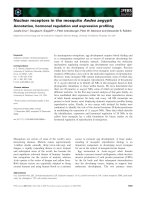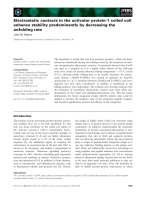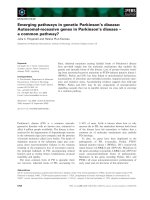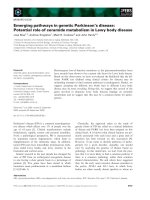Báo cáo khoa học: "Historical Change in Language Using Monte Carlo Techniques" potx
Bạn đang xem bản rút gọn của tài liệu. Xem và tải ngay bản đầy đủ của tài liệu tại đây (392.54 KB, 16 trang )
[Mechanical Translation and Computational Linguistics, vol.9, nos.3 and 4, September and December 1966]
Historical Change in Language Using Monte Carlo Techniques*
by Sheldon Klein, Carnegie Institute of Technology, Pittsburgh, Pennsylvania, and
System Development Corporation, Santa Monica, California†
A system has been programmed in JOVIAL to serve as a vehicle for test-
ing hypotheses about language change through time. A basic requirement
of the system is that models must be formulated within the framework of
Sapir's concept of drift and Bloomfield's definition of a speech community.
Outside these restrictions, an experimenters selection of hypotheses is
free. The system, which can be viewed as performing Monte Carlo simu-
lations of group, language change, has been successfully tested in several
computer runs using an extremely simple model of linguistic interaction.
(The system, and any model tested within its framework, are separate
entities. Accordingly, the use of a trivial model to check out the operation
of the system does not depreciate its ability to handle models of vast
complexity.) The initial test population consisted of fifteen adults and five
children, each represented by a phrase-structure generation-recognition
grammar. The grammars and the frequency parameters associated with
their individual rules were not necessarily identical. During the course of
a run some individuals died and others were born. Newborn children
acquired the language of the community. The units of interaction con-
sisted of conversations that were produced by the grammars of speakers
and parsed by the grammars of auditors. The linguistic structure of a
conversation determined changes in the auditor's grammar. Decisions in
the system were made with random numbers on the basis of weighted
frequency parameters. To insure control of free variables before under-
taking experiments with factors causing change, the goal of the initial
experiment was to obtain a condition of linguistic stability and essentially
identical results for the population as a whole from several computer runs
which differed only in the choice of random numbers referred to in de-
cision-making processes. Such results were obtained; even though the
fate of individual members of the speech community varied widely in
the different trials, the mean values of the frequency of the grammatical
rules in the total population were very similar at identical time periods in
each run, for a simulated span of twenty-five years and the structure
equilibrium state.
I. Introduction
Computer simulation of real-world events for the pur-
pose of prediction or of testing the validity of models
has numerous precedents in the behavioral sci-
ences.
1-8
The first step in such a simulation is the
formulation of a model in terms that can be imple-
mented in a computer program. A strong check on the
validity of the assumptions in the model is successful
prediction of pertinent events. For some types of simu-
* This research is supported in part by grant MH-07722, National
Institute of Mental Health, U.S. Public Health Service (to the Car-
negie Institute of Technology). Portions of this paper were presented
at the 1964 and 1965 winter meetings of the Linguistic Society of
America and before the Computation and Control Colloquium, Har-
vard University, March, 1966. The author is grateful to Herbert A.
Simon, John T. Gullahorn, and Frank N. Marzocco for their comments
and suggestions.
† Now at the University of Wisconsin, Madison.
lation, such as the behavior of laboratory animals in a
hypothetical experiment, a model can be considered
adequate if the simulated behavior falls only within
the range of behavior of real animals in a live experi-
ment. In general, a model can be considered valid
even if its predictions are only statistically significant
approximations of real-world behavior.
Simulation experiments may model the behavior of
a single entity or that of a large population. The num-
ber of entities used in a simulation may be equal to a
total population or may be viewed as representing a
small sample of a very large population.
The term “Monte Carlo,” adopted because of its
gambling connotations, refers to the use of random
numbers as determiners of events in a simulation. The
events that take place may be random only within the
constraints of posited stochastic relationships that gov-
ern probabilities of transition from one state of events
67
to another. The transition probabilities may be either
constant or altered during the course of a simulation.
Assume, for example, that under certain conditions a
given event has a 0.2 chance of occurring. Further
assume that the pertinent conditions exist. The simula-
tion system would refer to a source of random or
pseudorandom numbers for a fraction in the range
0-1, implementing the event only if that number were
in the range 0-0.2.
In evaluating the predictions of a system incorporat-
ing such decision-making devices, it is essential to de-
termine the effects of different choices of random num-
bers. This is normally accomplished by repetition of
the same simulation with different random numbers. The
pertinent data may then appear in the form of a statisti-
cal analysis of the behavior in the repeated trials.
A simulation may yield several kinds of information
of interest to a researcher. For example, it might be of
interest to know that a model predicted a state C from
a state A and also to know that in the course of pre-
diction it simulated an intermediate state B.
The program described in this paper is a vehicle for
the testing of diverse models of language change.
While, in the course of my work, I may test the im-
plications of some particular models, the program it-
self will serve, hopefully, as a general tool for conduct-
ing a variety of simulation studies.
II. The Basic Design of the Simulation System
The program, which is written in
JOVIAL, an ALGOL
compiler language, is designed to simulate the inter-
action of members of a speech community among them-
selves and with members of other communities. It is
flexible enough to model special relations among par-
ticular members, for example, family groups and social
classes; to simulate the transmission of language from
one generation to the next; and to handle the phe-
nomena of multilanguage acquisition.
While the experimenter has a large range of choice
in designing models for simulation, certain basic as-
sumptions about group language phenomena are in-
herent in the design of the program and are more or
less unalterable. Such assumptions are analogous to
definitions and metatheorems in a system of formal
logic. Except for the concept of “generation grammar,”
none of these primitive assumptions is alien to readers
of Sapir and Bloomfield. The assumptions are consistent
with Sapir's concept of “drift” (ref. 9, pp. 165-66):
Language exists only in so far as it is actually used—
spoken and heard, written and read. What significant
changes take place in it must exist, to begin with, as indi-
vidual variations. This is perfectly true, and yet it by no
means follows that the general drift of language can be un-
derstood* from an exhaustive descriptive study of these
* “Or rather apprehended, for we do not, in sober fact, entirely
understand it as yet”[ref. 9, p. 166, n. 8].
variations alone. They themselves are random phenomena,†
like the waves of the sea, moving backward and forward in
purposeless flux. The linguistic drift has direction. In other
words, only those individual variations embody it or carry
it which move in a certain direction, just as only certain
wave movements in the bay outline the tide. The drift of a
language is constituted by the unconscious selection on the
part of its speakers of those individual variations that are
cumulative in some special direction. This direction may
be inferred, in the main, from the past history of the lan-
guage. In the long run any new feature of the drift becomes
part and parcel of the common, accepted speech, but for
a long time it may exist as a mere tendency in the speech
of a few, perhaps of a despised few. As we look about us
and observe current usage, it is not likely to occur to us
that our language has a “slope,” that the changes of the
next few centuries are in a sense prefigured in certain ob-
scure tendencies of the present and that these changes,
when consummated, will be seen to be but continuations
of changes that have already been effected.
The basic assumptions of the simulation system are
also consistent with Bloomfield's thoughts about the
nature and formal representation of the concept of
“speech-community” (ref. 10, pp. 46-47).
The most important differences of speech within a com-
munity are due to differences in density of communication.
The infant learns to speak like the people round him, but
we must not picture this learning as coming to any particu-
lar end: there is no hour or day when we can say that
person has finished learning to speak, but, rather, to the
end of his life, the speaker keeps on doing the very things
which make up infantile language-learning . . . Every speak-
er's language, except for personal factors which we must
here ignore, is a composite result of what he has heard
other people say.
Imagine a huge chart with a dot for every speaker in
the community, and imagine that every time any speaker
uttered a sentence, an arrow were drawn into the chart
pointing from his dot to the dot representing each one of
his hearers. At the end of a given period of time, say
seventy years, this chart would show us the density of
communication within the community. Some speakers would
turn out to have been in close communication: there would
be many arrows from one to the other, and there would be
many series of arrows connecting them by way of one, two,
or three intermediate speakers. At the other extreme there
would be widely separated speakers who had never heard
each other speak and were connected only by long chains
of arrows through many intermediate speakers. If we wanted
to explain the likeness and unlikeness between various
speakers in the community, or, what comes to the same
thing, to predict the degree of likeness for any two given
speakers, our first step would be to count and evaluate the
arrows and series of arrows connecting their dots. We shall
see in a moment that this would be only the first step; the
reader of this book, for instance, is more likely to repeat a
speech-form which he has heard, say, from a lecturer of
great fame, than one which he has heard from a street-
sweeper.
† “Not ultimately random, of course, only relatively so” [ref. 9,
p. 166, n. 9],
68
KLEIN
The chart we have imagined is impossible of construc-
tion. An insurmountable difficulty, and the most important
one, would be the factor of time: starting with persons now
alive, we should be compelled to put in a dot for every
speaker whose voice had ever reached anyone now living,
and then a dot for every speaker whom these speakers had
ever heard, and so on, back beyond the days of King Alfred
the Great, and beyond earliest history, back indefinitely
into the primeval dawn of mankind: our speech depends
entirely upon the speech of the past.
Since we cannot construct our chart, we depend instead
upon the study of indirect results and are forced to resort
to hypotheses. We believe that the differences in density of
communication within a speech-community are not only
personal and individual, but that the community is divided
into various systems of sub-groups such that the persons
within a sub-group speak much more to each other than to
persons outside their sub-group. Viewing the system of
arrows as a network, we may say that these sub-groups are
separated by lines of weakness in this net of oral communi-
cation. The lines of weakness and, accordingly, the differ-
ences of speech within a speech community are local—due
to mere geographic separation—and non-local, or as we usu-
ally say, social.
Simulation of drift through a dynamic implementa-
tion of Bloomfield's concept of speech community, in
which the density of communication is determined by
probability values rather than statically mapped by
lines of interaction, is a goal implicit in the design of
the simulation system. Any programing of models or
testing of hypotheses with this program must take place
within this basic framework.
A. POPULATION
Each member of a speech community is represented
in the program by a generation grammar and a recogni-
tion grammar. Individuals with command of more than
one language may be associated with additional gram-
mars. A grammar consists of a set of rules for either
parsing or generating forms in a particular language.
The grammars of individuals are not necessarily
identical. During the course of a simulation, various
individuals will die, and new ones will be born. A
death requires the deletion of the grammars associated
with the deceased; a birth, the addition of new gram-
mars. The grammars representing newborn children are
empty. An adult just entering an alien speech com-
munity may acquire empty recognition and generation
grammars in addition to the non-empty ones he may
possess as a member of another speech community.
The program is flexible with respect to the kinds of
recognition- and generation-grammar rules it may use.
These rules may be limited just to syntax, just to
phonology, or to syntax and semantics; or they may
pertain to any range of linguistic phenomena that some
theory might designate as significant. Accordingly, the
program can use either stratificational or transforma-
tional grammar models and might manipulate rules
pertaining to phonemes or distinctive features, semo-
lexemic rules or transformations.
This flexibility is possible because the program is
designed to treat grammar rules as data in tables.
While program modifications might be necessary for
certain types of rule systems, these changes would be
required only in the generation-parsing component of
the system. The system's basic structure would remain
constant.
The first testing of the simulation program will use,
as a matter of convenience, an approximation to a
stratificational model that contains dependency and
phrase-structure rules and manipulates dependency
networks and rules of co-occurrence to approximate re-
lations between sememic and lexemic entities. The par-
ticular model, which I have described elsewhere,
11,12
is
convenient because it is associated with an operational
generation-parsing system that is ready to serve as a
basic component in the simulation system.
B. UNITS OF INTERACTION
The basic units of interaction are speech forms pro-
duced in response to other speech forms. A good por-
tion of the simulation will consist of small conversa-
tions among members of the population. A monitoring
system controls the choice of interacting members.
A fundamental assumption of the simulation is that
a major cause of change is the differences in the gram-
mars of various members of a community. These dif-
ferences are manifested in the varying speech forms
produced during interactions. Assume that individual A
has directed an utterance to individual B. B will at-
tempt to parse the utterance with the rules available in
his own recognition grammar. Each time B applies a
particular rule in recognition, there might be an in-
crease in a parameter value controlling the frequency
of its usage in his generation grammar. If B's rules are
not adequate for any step of the parsing, he may tem-
porarily modify some of his own rules or temporarily
borrow a rule from A in order to complete the parsing.
Whether or not the temporary changes or borrowings
are made permanent would be governed by other prob-
ability parameters. Changes might first be limited to
the recognition grammar and permitted to enter the
generation grammar only when the value of parameters
sensitive to usage frequency passed a threshold. (Rules
about vocabulary as well as the phonemic interpretation
of phones are treated as part of the recognition- and
generation-grammar systems.)
If rules pertaining to meaning are included, the con-
versations may be required to be coherent and to ad-
here to particular content areas.
C. STRUCTURE OF THE PROGRAM
The components in the system are data tables and dy-
namic programs.
13
One of the major data tables contains
HISTORICAL CHANGE IN LANGUAGE
69
the sets of recognition and generation grammars repre-
senting the members of speech communities. Associated
with each set of grammars are parameter values per-
tinent to the contents of the other major data table, a
list of stochastic relationships applicable to a simulation.
The major dynamic components are a program for
parsing and generating speech forms and a monitoring
system that controls the flow of the simulation. The
recognition-generation component also has the task of
modifying the grammars of individuals in the system.
The design of this component may require alteration
for simulations incorporating different theories of gram-
mar or different notation for grammar rules belonging to
the same conceptual genre. The tasks of the monitor-
ing system include determining the passage of time
and taking a periodic census to inform the experimenter
of the changes that have taken place at various stages
of the simulation.
III. The Modeling Process
Section II provided a description of the basic model.
The term “basic” is used because the description re-
fers to the program implementation of unalterable,
primitive assumptions about the representation of mem-
bers of a speech community and their mode of interac-
tion. As indicated above, these assumptions are roughly
analogous to definitions in an axiomatic system.
The analogue of axioms consists of posited stochastic
relationships pertinent to the interactions among mem-
bers of a community. The choice of such relationships
is at the option of the researcher, and he may select
them to represent a particular theory about the nature
of language change and also to represent particular
facts or hypotheses about historical events and social
relations pertinent to a given simulation. Some typical
assumptions likely to be common to many models
might include:
1. A parent is more likely to speak to his child than
to a member of the community selected at random.
2. A child is more likely to speak to his parent than
to a member of the community selected at random.
3. A husband is more likely to speak to his wife than
to a member of the community selected at random.
4. A wife is more likely to speak to her husband than
to a member of the community selected at random.
5. Each time an individual interacts with a par-
ticular member of the community, the probability of
future interactions with that member increases.
6. A child is more likely to adopt a grammar rule
from a parent than from another member of the com-
munity selected at random.
7. An adult is less likely to adopt a grammar rule
from a child than from another adult.
To incorporate the preceding assumptions in the pro-
gram, the phrases “more likely” and “less likely” are
redefined in terms of specific probability values, and
a statement such as “the probability . . . increases”
is redefined in terms of a mathematical function. Prob-
ability values are placed in the parameter lists associ-
ated with each grammar system in the community;
mathematical functions that refer to the parameters
are placed in the table of stochastic relationships. The
number and kind of assumptions that can be incorpo-
rated in a simulation are limited only by the amount of
available computer storage space, and indirectly by
the availability of sufficient computer time to meet the
requirements of increasingly complex simulations. For
example, it is possible to model the effects of the exist-
ence of a prestige group within a community by the
addition of such rules as:
8. A member of the prestige group is more likely to
adopt a grammar rule from another member than from
a non-member.
9. A non-member of the prestige group is more likely
to adopt a grammar rule for a member than from a
non-member.
10. Members of the same groups (prestige and non-
prestige) are more likely to speak to each other than
to members of other groups.
The experimenter may define a community sub-
group by presetting pertinent parameters of the sub-
group members to the same values. The treatment of
multilingual contact is merely an extension of the same
devices. A multilingual speaker is associated with
grammars for each of his languages, and each grammar
system may be associated with different parameter val-
ues. Also, special stochastic relationships may be
posited for rule-borrowing between individuals speak-
ing different languages or even for the transfer of rules
between different grammar systems associated with a
single individual. In general, the selection of proper
parameter values and stochastic relationships should
permit an experiment to model a variety of social con-
ditions pertinent to speech interaction: marriage be-
tween speakers of different languages, sporadic inter-
action between members of different speech communi-
ties, even the appearance of foreign peddlers selling
popular trade goods. (In this last example, the popu-
larity of trade goods might be represented by associat-
ing a high probability of being borrowed with the
names of the trade items listed in the vocabulary por-
tion of a peddler's grammar.)
It is even possible to model the interaction of several
speech communities in a particular geographical rela-
tionship. For example, consider a situation in which
four speech communities, A, B, C, and D, are located
so as to form the corners of a square surrounding a
central community, E. This geographical distribution
could be modeled by rules stating that interactions be-
tween members of communities A and C or B and D
are less likely to occur than between members of other
groups. The effects of physical barriers to communica-
tion, such as intervening rivers or mountains, could be
70
KLEIN
similarly approximated.
The sudden splitting of a single speech community
into two groups can be modeled by assigning zero
probabilities of interaction to members of diverging
groups at a specified point in time. A gradual split tak-
ing place over a lengthy period of time can be modeled
by a stochastic relationship that decreases the probabil-
ity of interaction as a function of elapsed time. The
complementary situation in which one speech commun-
ity gradually migrates into the territory of another can
be modeled by the use of a function that increases the
probability of interaction as a function of elapsed time.
The experimenter is also free to implement various
models of individual-grammar change, for example, spe-
cial hypotheses about language acquisition by children
and the effects of functional load or symmetry on indi-
vidual-grammar modification.
IV. Simulation Experiments
One of the major goals of this research is to perform
simulations that will model language changes corre-
sponding to events in the real world, that is, to predict
a later stage of a language from a description of an
earlier stage. But there are less ambitious experiments,
which must be performed first, that may be of interest
in themselves. For example, one must determine if the
general design of the simulation system is capable of
maintaining reasonable properties of language through
time, both on an individual and a group basis. Con-
ceivably, logical inconsistencies in a theoretical model,
in the choice of stochastic rules, or in parameter values
might cause the grammars representing the population
to lose most of their rules after a few generations of
interaction; or perhaps all members of the population
might quickly acquire exactly the same grammars; or
worse, grammars might diverge to such an extent that
within a generation or two each member of the popula-
tion would speak a different language.
It is also essential to determine if the simulation
model can actually reflect language changes in the
range of observed phenomena. For example, independ-
ent of prediction, one must determine if a model has
the capability of simulating a sound shift—any sound
shift, real or hypothetical.
At this stage one might check the internal validity of
one's behavioral model of language-learning to insure
that the development of language in the children of the
simulation corresponds with language-acquisition be-
havior of children in the real world.
While, for a given model, there may exist combina-
tions of parameters and rules capable of simulating ac-
ceptable real-world language change, they may be rare
enough to hinder experimentation. Hopefully, this pes-
simistic result will not occur. I expect that preliminary
experimentation with a model will yield insights about
combinations of parameter values that should be
avoided and about combinations that are likely to yield
system behavior conforming to real-world language
phenomena.
This kind of testing is much like tuning an auto-
mobile engine. The system may be extremely sensitive
to particular combinations of parameter values, for
example, a .5 probability of a parent interacting with
his child, in combination with a .3 value of interacting
with a stranger, might produce unacceptable system
behavior, while any choice greater than .6 for the
former and less than .2 for the latter might yield satis-
factory results. In such an instance the mathematical
functions pertinent to this area of interaction should be
ones that do not permit the parameters to attain values
outside those limits. It is likely that such a tuning will
be necessary for every new modeling experiment in-
volving different languages and/or different stochastic
relationships. As part of the methodology of "tuning,"
one should first test the effects of only a part of the as-
sumptions of a model, gradually adding the remainder
as the more simple models are made to function satis-
factorily.
Also, as indicated in Section I, it is essential to de-
termine the effects on a simulation of different choices
of random numbers. If a model is inadequate, runs
differing only in the selection of random numbers may
yield widely divergent behavior. The anticipated re-
sults with an adequate model would be divergent be-
havior—but with the divergence falling within a range
too small to invalidate the model. For example, a model
might be considered adequate if it predicted only hypo-
thetical dialect variants of an attested stage of a lan-
guage.
A. PREDICTION OF HISTORICAL EVENTS
One might attempt to use the simulation system to pre-
dict the future of a contemporary linguistic situation.
The accuracy of the predictions would, of course, not
be verifiable in the experimenter’s lifetime. More fruit-
ful experiments might involve predicting successive
stages in the development of a language or language
family in cases where the results could be checked
against written records. Such records must be adequate
for the construction of recognition and generation
grammars. One would also wish to incorporate infor-
mation pertaining to social structure, material culture,
and geography and, if possible, detailed information
about trade routes, migrations, and dated changes in
social structure. If, for example, records indicate that
barriers between certain social classes disappeared after
a certain date, one might arrange for the program to
alter the pertinent interaction parameters at the ap-
propriate time during the course of the simulation.
In the absence of exact historical detail, one may run
a simulation that posits the missing information and
perhaps tests for its adequacy in accounting for future
HISTORICAL CHANGE IN LANGUAGE
71
changes in a language. For example, can the simulation
predict adequately if it assumes the unattested exist-
ence of trade contacts between two widely separated
communities, the unattested introduction at a particu-
lar time of foreign terms for popular items of material
culture, or the unattested existence of an indigenous
community speaking an alien language having specific,
hypothetical, but unattested grammatical features?
Ideally, results of historical-simulation studies would
be adequate predictions that used only documented
facts. If one is forced to incorporate speculations about
history, successful prediction is not as impressive. In
such cases there is justification for claiming only that
the model is but one consistent, plausible theory about
the factors pertinent to the language change. (It must
be conceded that, at some level, a model always con-
tains unverified speculations and that one is never
justified in making a claim broader than the preceding.)
If possible, one should try to predict the same results
with various combinations of speculations. Each model
that accurately predicts the same results is (within the
limits of the simulation system) a theory about the
causes of change in the test case. Analysis of runs with
different models might yield information about hy-
potheses common to successful simulations or about the
mutual incompatibility of certain combinations of
hypotheses.
Another use of the program would be to test the
relative validity of two hypotheses about factors of
change. At best, one hypothesis would yield a valid
prediction, the other fail. At worst, both would fail.
More frequently, neither might yield wholly satisfac-
tory predictions, but one prediction might be a little
more accurate than the other. Note that the deter-
mination of relative accuracy might rest on many fac-
tors; for example, the only significant difference be-
tween two models might be that one predicts a veri-
fiably false date for a minor innovation.
B. ANALYTIC SIMULATIONS
Given success in simulating historical events, one might
wish to test the relative significance of various param-
eters in the system. Such testing, although similar to
the "tuning" described in Section IV, is to be per-
formed only after a successful predictive simulation.
In essence, it would determine the range of values for
a particular parameter within which the results were
not significantly altered, for example, mean age at
death or mean age difference between marriage part-
ners.
Another type of simulation that must be considered
analytic is the use of grammars of reconstructed lan-
guages for predicting the languages upon which the
reconstructions were based. Certainly the pitfalls of
circular reasoning are present for almost any conclu-
sion to be drawn from a successful prediction. On the
other hand, it is not clear to me what the significance
of a failure would be. Nevertheless, assuming success-
ful predictions have been made with real documented
data, the temptation to perform such analytic experi-
ments might be very great. Perhaps the only signifi-
cance of such testing might be to determine whether
the type of model necessary for successful simulation
with reconstructed data were any different from that
required for simulations based on attested grammars.
V. Discussion of Methodology
This paper describes a system for simulating language
change within the framework of models selected at the
discretion of an experimenter. Without external veri-
fication, the validity of any conclusions drawn from a
simulation can be no greater than the validity of the
individual assumptions incorporated in the associated
model. While accurate prediction may be a criterion of
success, it does not guarantee that a model accurately
represents real-world events. There might exist any
number of models, some mutually incompatible in their
assumptions, that could yield equally accurate predic-
tions.
Failure to predict accurately does not necessarily im-
ply that some assumptions in a model are invalid. The
model itself may have been particularly sensitive to a
parameter that was not sufficiently varied in the simu-
lations, or perhaps some highly improbable but signifi-
cant event occurred in the real history of a language
and was not incorporated in the set of otherwise valid
assumptions of a particular model.
The ultimate function of simulation is to provide a
researcher with a formal mechanism of inquiry in situ-
ations where static deductive testing of the implications
of a model is not feasible because of the complexity of
the phenomena involved. Explanations about historical
change dependent upon unverifiable hypotheses can
be tested for adequacy and internal consistency, not
for validity. However, if the predictions of a simula-
tion have been accurate, one may presume that the
validity of any underlying unverifiable premises is at
least as great as similar assumptions in untested models,
formal or otherwise.
VI. Testing the System: Simulation of Twenty-Five
Years in a Hypothetical Speech Community
It is essential to note that the simulation system and
any given model of language change are separate en-
tities. As a vehicle for testing the functioning of the
simulation system, I have made use of an extremely
simple model that I do not wish to defend as a real-
world model of language change. Rather, its testing
is to be interpreted as indicating that the simulation
system works and is capable of operating with more
powerful models.
72
KLEIN
A. AN ULTRA-ELEMENTARY MODEL
The initial population consisted of twenty speakers:
fifteen adults and five newborn children. Age and
status were the two parameters associated with each
member of the community that were not directly con-
nected with grammar rules. The age of each adult
was chosen randomly. Each child was assigned age
zero. The status of each adult was selected randomly.
Only phrase-structure-dependency rules were con-
tained in the grammars. There were a total of eleven
different rules contained in the community. A listing of
the rules may be obtained from any of Tables 1-6. A
typical rule is ART0 +*N1 N2. The existence of an
equals sign between the N1 and the N2 is implied. The
asterisk is data pertinent to the dependency-analysis as-
pect of the rule and indicates that the article is de-
pendent on the head of the noun phrase. The depend-
ency aspect of the rules was not pertinent to the test-
ing of this particular model. As indicated earlier, an
automatic essay-paraphrasing system that made use of
dependency criteria served as the basic component for
the construction of the simulation system. Although
every parsing in the test runs included a dependency
as well as a phrase-structure analysis, the simulation
made no use of dependency criteria. The exact use of
the rules in generation and parsing is described else-
where.
11,12
The rules governing the simulation runs included the
following:
1. Probability of a speaker x speaking to an auditor
y at time t:
1 — | (status of x at time t) — (status of y at time t) |
7
2. Status of speaker x at time t + 1 after speaking
to an auditor y at time t:
(status of x at time t) —
(status of x at time t) — (status of y at time t)
7 .
3. Status of auditor y at time t + 1 after listening
to a speaker x at time t:
(status of y at time t) —
(status of y at time t) — (status of x at time t)
4
4. Status, at time t + 1, of potential participants in
a conversation at time t who did not converse: + 0.01
for the individual of greater status; — 0.01 for the in-
dividual of lesser status.
5. Status of a newborn child: a random value be-
tween 0.01 and 0.99.
6. Frequency weight of a grammar rule m at time
t + 1 that was used one or more times in the parsing
of a single sentence at time t:
(frequency weight of m at time t) +
0.03 x (subscript of the right half of rule).
The computation is applied repeatedly during time
interval t for as many sentences as there are in the dis-
course.
7. Frequency weight of a grammar rule m at time
t + 1 that was not used in the parsing of a single sen-
tence during time interval t:
(frequency of m at time t) —
(an average decrement of 0.003);
that is, there is a 30 per cent chance of a 0.01 decre-
ment. The computation is applied repeatedly during
time interval t for as many sentences as there are in
the discourse not pertinent to rule m.
8. Threshold frequency weight for adding or remov-
ing a rule from a grammar: 0.02.
9. Initial frequency weight of a rule borrowed by an
individual under two years of age: 0.20; over two years
of age: 0.40.
10. Probability of death for an individual in a given
year: age/1,000 for speakers over ten years of age,
0.10 for speakers ten years and under.
Except in the case of rule 4, all computed values
greater than 0.99 are rounded to 0.99; values computed
as less than 0.01 are rounded to 0.01. In the case of
rule 4, the rounding is to 0.98 and 0.02, respectively.
Also, no distinction between generation and recogni-
tion grammars was made with reference to the status
of rules; a rule was either in a particular grammar for
both generation and parsing or not present at all.
The flow of the group interaction can be described in
terms of major and minor cycles. Each member of the
population is assigned a number. A major cycle is be-
gun by picking the first member as speaker. The sec-
ond member of the population is then considered a
potential auditor. Whether or not he is selected is de-
termined by the first rule and reference to a random-
number generator. Whether or not a conversation takes
place, the clock of the system is incremented by one
minimal time unit. The process is repeated for the
third and successive members of the community. When
each member of the community has been considered as
a potential auditor of the speaker, a minor cycle has
been completed. The second member of the population
is then selected as speaker of the next minor cycle.
When every member of the community has served as
speaker for a minor cycle, a major cycle has been com-
pleted. One major cycle is equivalent to one year. The
number of minimal time units in a minor cycle is
equal to the number of individuals in the population—
in this case, twenty.
The birth rate in the model is identical to the death
rate. The probability of death for an individual is com-
puted each time he is selected as speaker for a minor
cycle. If a random number falls within the appropriate
range, that individual dies before he has a chance to
HISTORICAL CHANGE IN LANGUAGE
73
talk. He is immediately replaced by a newborn child
with the same number, an age of zero, and a randomly
determined status.
Newborn children in this particular model do not
have completely empty grammars. Rather, they are as-
signed that minimum of rules to generate the simplest
well-formed sentence: N4* + V3 = S1, N0 = N1, and
V0 = V1. Their inclusion does not indicate the author's
commitment to any theory of innate ideas but rather
was necessary as a programing expedient. The fre-
quency weight permanently assigned to these rules was
0.04.
B. TESTING THE MODEL
The exact forms of the rules of the model, especially
the values of constants, were selected after much trial
and error. The goal of the testing was to attain a situa-
tion of stability for the mean frequency weights of the
grammar rules. Early versions of the model rules led to
74
KLEIN
loss of all grammar rules, to attainment of maximum
frequency weight for every rule, or to some combina-
tion of factors that led to maximization of frequency
weights for some grammar rules and loss for others.
The current model is of such a nature that the fre-
quency weights of most grammar rules would reach
asymptotes of 0.99 were it not for the fact that the
death rate is such that individuals usually die before
the weights of their rules all reach such values.
Tables 1-6 contain results of censuses taken every
five years during a span of twenty-five years for each
of three separate runs. Each census indicates the num-
ber of speakers possessing each grammar rule, the
mean frequency of each rule among speakers actually
possessing it, and the mean frequency of each rule in
the total population. The censuses in the tables were
constructed from actual computer output, and all val-
ues are expressed as octal integers. To convert such
values to the decimal system, multiply each integer
going from right to left by successive powers of eight,
HISTORICAL CHANGE IN LANGUAGE 75
for example, an octal integer, 132, may be converted to
the decimal system as follows: 2 × 8° + 3 × 8
1
+ 1
× 8
2
= 2 × l + 3 × 8 + l × 64 = 90 in the deci-
mal system. The number of speakers indicated in the
censuses is always an integer. The frequency weights,
although expressed as integers, are to be treated as
decimal fractions in the range 0.01-0.99 after the con-
version from octal integer to decimal integer has been
completed. Thus, a value of 143 in a census table is to
be ultimately interpreted as the decimal value, 0.99.
Figures 1—4 contain graphs of the mean frequencies
in the total population for selected rules (on the basis
of yearly censuses). Figures 5-8 contain graphs repre-
senting the number of speakers possessing the rules
mentioned in Figures 1-4 (also on the basis of yearly
censuses).
The frequency increment of a rule used in para-
phrasing is, as rule 6 of the model rules indicates, a
function of the subscript of the right half of a gram-
mar rule. The subscripts control the order of applica-
76
KLEIN
HISTORICAL CHANGE IN LANGUAGE
77
78
KLEIN
tion of the rules in parsing and generation. The use of
subscripts as a factor in computing frequency-weight
increment was an empirical attempt to reflect the ten-
dency of some high subscript rules to have a much
lower frequency weight than those with lesser sub-
scripts. The decrement for weights of rules not used in
parsing does not involve subscripts. It was necessary
to keep the frequency weight of the terminal rules, N0
= N1 and V0 = V1, a low constant value to prevent
the loss of most other rules from each grammar.
As indicated, a total of three runs was performed
with the model. They differed only in the choice of
random numbers presented to the decision-making por-
tions of the program. The initial populations in each
run were identical in composition. The creation of the
starting population was accomplished as follows:
An additional speaker, possessing every rule in the
system (with randomly assigned frequency weights)
was set to converse with every other individual in the
population in a preprocessing minor cycle. (Newborn
HISTORICAL CHANGE IN LANGUAGE
79
babies were omitted.) Rule 1 of the model, governing
probability of interaction, did not apply. Each auditor
had only the grammar rules of a newborn child; a pre-
assigned, randomly determined status; and a randomly
determined age. Rules borrowed by auditors entered
their grammars with a frequency weight equal to 65
plus a randomly determined value between 0 and 30.
After the initializing minor cycle, the primordal speaker
was eliminated from the system. I assume no responsi-
bility for the philosophical implications of this method
of creating a starting population.
The initializing procedure was identical for each of
the three trial runs, which were permitted to deviate
from one another subsequently. While the fate of vari-
ous individuals differed widely in each run, the mean
frequencies computed in the censuses appear quite
close at identical time periods. What of course is meant
by "close"? Statistical interpretation of the results is
complicated by the problem of choosing a pertinent
test. Should the population in the various runs be
80
KLEIN
treated as a sample of the total group? If a sample,
from what size population? One might compute the
mean frequency of all census mean frequency values at
each time interval, then check to see if any individual
values fall outside a computed standard error. But this
is a weak test. Its use might indicate success where a
linguist might judge failure; for example, a linguist
might feel the linguistic situations emergent from dif-
ferent trials were too divergent to be considered as
variants of the same language, even though all census
values fell within the range of the standard error. A
graphic display of the results may present evidence as
least as convincing as any statistical test. In any case,
a sample of three runs is too small for any statistical
test to be of much significance. In my opinion, the
graphs in Figures 1-8 are sufficiently convincing that
the claim for similar results at similar time intervals is
justified. The graphs also suggest that a near equilib-
rium state was attained in the later years of each run.
The sharp rise in mean frequency weights at the begin-
HISTORICAL CHANGE IN LANGUAGE
81
ning of each run is most likely due to the random and
independent assignment of frequency weights to in-
dividual rules. The rules in a grammar are not inde-
pendent of each other. Neither is their usage in a gen-
eration system. Accordingly, the initial conditions were
unstable. The functioning of the system seemed to
force the values onto stable levels.
As indicated earlier, the purpose of the computer test
was to check out the simulation system rather than the
model. I believe that the results are a positive indica-
tion of the feasibility of simulating group language be-
havior within the conceptual framework described in
Sections I-V of this paper. In other words, while the
model is trivial, the simulation system and the implied
methodology are not.
Received May 23, 1966
References
1. Orcutt, B., Greenberger, M., Korbel, J., and Rivlin, A.
Microanalysis of Socioeconomic Systems: A Simulation
Study. New York: Harper & Row, 1961.
2. Bush, R., and Mosteller, F. Stochastic Models of Learn-
ing. New York: John Wiley & Sons, 1955.
3. Guetzkow, H. (ed.). Simulation in Social Science:
Readings. Englewood Cliffs, N.J.: Prentice-Hall, Inc.,
1962.
4. Hoggat, A. C., and Balderston, F. E. (eds.). Symposium
on Simulation Models: Methodology and Applications in
the Behavioral Sciences. Cincinnati: Southwestern Pub-
lishing Co., 1963.
5. Feigenbaum, E. A., and Feldman, J. (eds.). Computers
and Thought. New York: McGraw-Hill Book Co., 1963.
6. Hymes, Dell (ed.). Uses of Computers in Anthropology.
The Hague: Mouton & Co., 1965.
7. McPhee, W. N. Formal Theories of Mass Communica-
tion. New York: Free Press, 1963.
8. Gilbert, J. P., and Hammel, E. A., Jr. “Computer Simu-
lation and Analysis of Problems in Kinship and Social
Structure,” American Anthropologist, Vol. 68, No. 1
(February, 1966).
9. Sapir, E. Language. New York: Harcourt, Brace &
World, 1921.
10. Bloomfield, L. Language. New York: Holt, Rinehart &
Winston, 1933.
11. Klein, S. “Automatic Paraphrasing in Essay Format,”
Mechanical Translation, Vol. 8, Nos. 3 and 4 (June and
October, 1965).
12. ———. “Control of Style with a Generative Grammar,”
Language, Vol. 41, No. 4 (October-December, 1965).
13. ——— “Some Components of a Program for Dynamic
Modelling of Historical Change in Language.” (Pre-
prints of Invited Papers for 1965, Paper No. 14.) Inter-
national Conference on Computational Linguistics, New
York, May 19-21, 1965.
82 KLEIN

